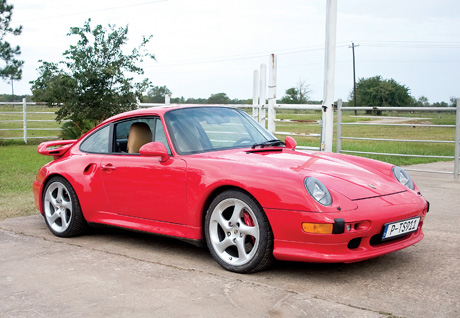SCM Analysis
Detailing
| Vehicle: | 1996 Porsche 911 Turbo |
| Years Produced: | 1996-1997 |
| Number Produced: | 5,978 |
| Original List Price: | $105,000 |
| SCM Valuation: | $45,000-$75,000 |
| Tune Up Cost: | $1,200 (30k service interval) |
| Engine Number Location: | On the engine case, below and to the right of the engine cooling fan, between the cooling fan housing and the a/c compressor |
| Club Info: | Porsche Club of America P.O. Box 1347 Springfield, VA 22151-0347 |
| Website: | http://www.pca.org |
| Alternatives: | 2000-2004 Aston Martin DB7; 1994-1999 Ferrari 355; 1996-2004 Lotus Esprit V8 |
| Investment Grade: | D |
This car sold for $43,450, including buyer’s premium, at the World Wide Group Auction in Seabrook, Texas, on May 1, 2010.
The 1996 and 1997 Porsche 911 Turbo is referred to as a 993TT by Porschephiles. Although the 1997 models had a handful of desirable upgrades, such as more robust first-gear input shaft and more malleable OBDII computer system, the Turbo of either model year is a ripping- fast car that represented the ultimate evolution of the air-cooled, flat-six 911. With sequential twin turbos, 400bhp and AWD, a 993TT will go, stop and turn better in reality than in your daydreams.
Almost incomprehensibly, a Turbo S (993TTS) then takes it to another level. Much of the catalog description for this car goes on and on about the Turbo S. While that is titillating, it is not really what was sold here. Our subject car is a custom, one-off something-or-other that slots in between a Turbo and a Turbo S.
A supercar in its own right
With a clear lineage to the ground-breaking technological masterpiece 959 model of Group B fame, a 993TT is a supercar in its own right. Fifteen years later, the performance stats still command respect. That is quite a statement in an era when this year’s Nissan Altima seems to have as many ponies as last year’s BMW M3. I believe the handsome, leather-bound Porsche owner’s manual describes a 0-60 mph time of 4.4 seconds and a quarter-mile time of 12.7 seconds. Most car magazines beat those numbers by half a second. Fiddle with the chip, as Porsche later did with the Turbo S, and you can break the four-second barrier.
On the Turbo C2S and C4S wide-body cars, the boring horizontal slats of the 993’s front fascia were engulfed by an open-mouth shape. Subtle, yet aggressive, brake cooling gills emerged on the bottom of the bumper cover just in front of the front wheels. The windshield, doors and window frames were all old friends, as they carried over from earlier 911 models.
Massive meats sveltely wrapped around 18″ hollow spoke, silver painted Porsche Twist wheels. The smooth curves of the wide rear fenders begged you to call them hips, and the functional, turbo-cooling wing was beautifully draped over the tail and flanks. Seeing such a smooth, organic form on the outside of a precision machine always reminded me of the melted clocks in a Salvador Dali painting.
Brakes, which are shared with C4S and C2S non-turbo models, were called “Big Reds.” Aluminum, carbon fiber and or rosewood bits and bobs were optional through Porsche’s equipment accessory line. And finally, though no one in their right mind would use it to drown out that splendid pairing of flat six whine and puffing turbo- whoosh, 993 Turbos came with Porsche’s 10-speaker stereo system. The head unit was antiquated Porsche, but the door panel speaker design was gorgeous.
Look at that “S” car go
As the catalog description indicates, a Turbo S was a 993TT on ‘roids. It had more power, thanks to that chip tweaking. The car also had more techie trim inside and out, additional breathing holes punched through the turn signals and front corners of the rear wing, and yellow brake calipers. Most uniquely, 959-style air ducts blended into the front edge of the rear fenders. About 180 Turbo S cars were built, which makes a Turbo S even rarer than a 959. But Turbo S cars are more likely to be seen stateside, as they were legally sold here. Bought new for more than $150k, most of these cars are squirreled away in Porsche collections by people who have full-time staff apply the goodies from Griot’s, but some are treated to a proper beating as road cars.
At the time of this writing, a Rennlist.com dialog explains that a very high mileage (70k ) very hammered Turbo S that has been parked outside, bird-bombed, and repaired for accident damage is asking all the money at $60k. This kind of abuse is not ordinary. A typical museum-quality example would still command more than double that.
To S or Not To S
The car sold at this auction is a “tribute.” It is a real 993TT, but it is not a Turbo S. Strangely, somebody went to the trouble and expense of making all the right cosmetic updates but two. These 18″ wheels appear to be from the next generation 996 turbo – the edges of their spokes are crisper than the 993TT wheels. And one more obvious omission has me wondering why anyone would carve the proper ductwork into the steel of the rear fenders – but skimp on painting the brake calipers yellow?
It’s not that this car isn’t fast or cool. It would fit into either of those buckets any day. But not fitting into the 993TT bucket or the 993TTS bucket is this car’s problem. This car’s lack of a proper bucket will continue to hold its value down by 10 to 20 percent under a stock 993TT. This car’s sale price was a terrific value, but it was not a bargain. With the “neither-here-nor-there” modifications, it was even less of an investment.
